The Reality of Mealtimes with Kids
Picture this: You’ve spent time preparing a healthy meal, set everything up just right, and sit down with your toddler—only for them to take one bite, throw food on the floor, or refuse to eat altogether. Sound familiar?
Mealtimes with little ones can be unpredictable, but setting realistic mealtime expectations can make all the difference. Rather than aiming for picture-perfect meals where everyone eats happily, adjusting your mindset can reduce stress, encourage healthy habits, and make mealtime more enjoyable for the whole family.
If you’re feeling overwhelmed by picky eating, short attention spans, or messy meals, you’re not alone! Let’s explore how to create healthy, achievable expectations and bring more joy to your family table.
1. Understand What’s Normal for Toddlers
The first step in setting realistic mealtime expectations is to understand what is developmentally appropriate for your child’s age.
✔ Toddlers are naturally unpredictable eaters. One day, they might love a certain food; the next, they act like it’s poison.
✔ Appetites fluctuate. Growth spurts and activity levels impact how much they eat.
✔ Food play is learning. Smushing peas, dipping everything in yogurt, or throwing food off the tray are part of sensory exploration.
Instead of worrying if your child eats a “perfect” meal every time, focus on consistency over time. Their eating habits will balance out as they grow.
2. Shift the Focus from “Clean Plates” to Healthy Habits
It’s tempting to measure mealtime success by how much your child eats. But instead of pushing for an empty plate, aim for:
⭐ Exposure over consumption: Repeatedly offering a variety of foods—even if they don’t eat them right away—helps develop acceptance.
⭐ Autonomy over force-feeding: Allowing kids to decide when they’re full fosters a healthy relationship with food.
⭐ Positivity over pressure: Avoid bribing, forcing, or tricking them into eating. Instead, create a stress-free environment where they can listen to their hunger cues.
3. Keep Portions Toddler-Sized
One common frustration comes from expecting toddlers to eat adult-sized portions. Keep in mind:
🥄 A toddler’s stomach is about the size of their fist. Their portions should be smaller than you might think.
🥕 Start with small servings and let them ask for more—this keeps them from feeling overwhelmed.
🍎 Balance over the day, not per meal. If breakfast was light, they might eat more at lunch. That’s okay!
💡 Tip: Using baby-friendly utensils like the Little Grubbers 3-in-1 Baby Spoon™ helps toddlers self-feed, making them more confident and engaged in meals.

4. Embrace the Mess—It’s Part of Learning
Mealtime messes are inevitable, but they’re also a sign of important learning and sensory development. Instead of stressing about spills and smears, try:
✔ Using a splat mat under the high chair for easy cleanup.
✔ Letting them explore textures by allowing some hands-on play.
✔ Providing a kid-friendly spoon like the Little Grubbers 3-in-1 Baby Spoon™ to encourage self-feeding while reducing frustration.
Mess now means more independent eating later!
5. Create a Calm and Positive Mealtime Environment
The atmosphere at the table affects how well toddlers eat. To encourage a pleasant mealtime:
🎵 Play soft background music to make meals feel relaxed.
🪑 Use a comfortable high chair that allows proper support.
🚫 Minimize distractions like screens or toys (but light conversation is great!).
😊 Stay neutral about food. No praise for eating or disappointment for refusal—keep it stress-free!
When kids feel comfortable and in control, they’re more likely to eat.
6. Be Patient with New Foods
It can take 10-15 exposures before a toddler accepts a new food. Instead of feeling frustrated when they refuse it the first few times:
🥄 Continue offering it without pressure. Just place it on the plate and let them decide.
🥕 Pair new foods with familiar ones so it feels less intimidating.
🎉 Make food fun! Try playful names like “dinosaur broccoli” or let them dip foods into sauces.
Consistency and a no-pressure approach go a long way in expanding your child’s food preferences.
7. Expect Short Attention Spans
Most toddlers won’t sit still for long, and that’s okay! Keep mealtimes:
🕰 Short and sweet (10-15 minutes max)—forcing them to stay longer often backfires.
🥄 Engaging but relaxed—ask simple questions or tell stories, but don’t force them to eat.
🔄 Routine-based—keeping meals at predictable times helps them know what to expect.
If they signal they’re done, respect it—forcing them to stay can create negative associations with mealtime.
8. Trust Their Hunger Cues
One of the most important realistic mealtime expectations is recognizing that kids naturally regulate their hunger.
✔ Some days they eat a lot; some days they eat a little. It balances out!
✔ Forcing extra bites can lead to power struggles and an unhealthy relationship with food.
✔ Toddlers won't starve themselves. If they refuse dinner, they’ll make up for it at the next meal.
Your job? Offer balanced meals and trust them to eat what they need.
Final Thoughts: Mealtimes Without the Stress
Setting realistic mealtime expectations makes family meals so much smoother. Instead of focusing on perfection, embrace small wins, create a positive environment, and trust the process.
💡 Make mealtimes easier with the right tools! The Little Grubbers 3-in-1 Baby Spoon™ helps toddlers self-feed with confidence, making mealtimes less stressful and more fun.
We’d Love to Hear from You!
What’s your biggest mealtime challenge? Share in the comments—we’d love to swap tips! 💬✨

